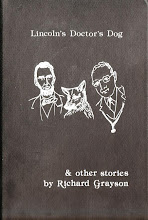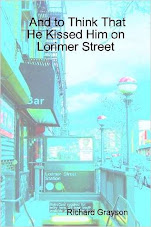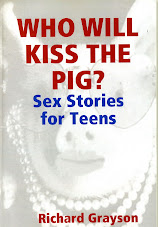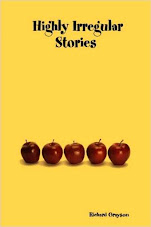
We went to a great poetry reading tonight at the Cornelia Street Café, our first time there. They have over 700 readings a year, twice an evening, and we're not sure how we ever missed it all these years. We were grateful for the early start at 6 p.m. and didn't mind the $7 admission, which included a free drink (Diet Coke with a twist in our case).
We sat at a back table near Greg Sanders, a great writer whose story collection Motel Girl was published by the evening's sponsor, Red Hen Press, which also brought out our own The Silicon Valley Diet nine years ago. (Greg will be reading with Ernest Hilbert, Elise Paschen, Timothy Green for Red Hen Press at KGB on Friday.)
Stephanie from Red Hen was nearby with the books from the four authors who were reading, but Red Hen Press's Kate Gale, who we've always thought of as the doyenne of the Los Angeles poetry and small press scene, was late. We did get to see Kate, whom we last saw last year when we sat with her and her co-publisher and husband, Mark E. Cull, who has designed some great covers for the press, including ours.
Red Hen Press


In Kate's absence, Angelo Verga, who is the curator of all things literary at Cornelia St. Café, emceed and gave nice introductions to the four poets. He's got a beautiful venue downstairs, with antique-looking mirrors on the walls, dark paneling and warm bare lightbulbs of green, yellow and red. We'll be back after having such a good experience tonight.

First up for the evening was Jamey Hecht, who read from his fascinating poetic take on JFK in Dallas and America in crisis,Limousine, Midnight Blue: Fifty Frames from the Zapruder Film.
In Midnight Blue, Jamey, born sometime in 1968 between the assassinations of Martin Luther King Jr. and Robert Kennedy, uses Abraham Zapruder's most famous home movie as a meditation on American culture. Jamey is a dynamic reader; at some points he was holding the book over his head with one hand as he read from one of the numbered frames of the Zapruder film. Here's Jamey reading "Z-150," one of the poems we heard tonight:
We especially liked the poem for frame Z-192:
Imagine me riding skeletal down Main Street on a bicycle.
I get death, you get the shock of your lives, your daughters
heroin addicts and your sons marines on fire in mud, guilty.
I am pedaling through perfect silence in the capital
of Dixie. Spit on the street when you mention me.
This Site Possesses National Significance
In Commemorating The History Of The United States
of America. 1993. National Park Service. United States
Department of the Interior. You rape my brain,
I haunt you. All my unfinished work impossible,
the very thought of me ridiculous, become an airport,
fried chicken, documentaries. Salute your Nazis.
Operation Paperclip. Go look it up. And while you die,
I and my midnight blue and silver bicycle go by.

The second reader was Amy Lemmon, who read from her just-published book, Saint Nobody. Amy's poems and essays have appeared in Rolling Stone, New Letters, Prairie Schooner, Verse, Marginalia, and other magazines, and iIn 2006 she was awarded the Ruskin Art Club Poetry Prize by Red Hen Press. In the fall, look for ABBA: The Poems, a chapbook Amy wrote in collaboration with our friend Denise Duhamel; it will be published by Coconut Books.

Amy, who this week has been guest-blogging at the Best American Poetry blog, is an accomplished and the snaps she got from audience members were well-deserved. Before she read, she spoke interestingly as the mom of Down syndrome child on a campaign we're interested in, to eliminate the use of the derogatory R-word. As the New York Times noted in yesterday's report by our friend Stuart Elliott, "Research found the derogatory expression 'is most extreme among older teenagers in high school and early college,'" so it's important to educate young people.

Amy read some wonderful poems from Saint Nobody that contained echoes of Blake and made us nostalgic. You can listen to Amy's poetry on the Bloomington radio station WFIU here. This is one of our favorite (somewhat older) Amy Lemmon poems, one that she didn't read tonight, "After Di Chirico’s The Uncertainty of the Poet":
First, you notice the torso, archaic but not Apollo’s
by a long shot. It has breasts, and callipygian hips,
but isn’t exactly Venus, either. The head’s fallen off
and the arms, blunt stumps, point mute questions.
The legs halt just below the buttocks. A bunch
of bananas blooms before the crotch, connected
by a dark strip I want to say is shadow, but. . .
Tarantula? Bloodstain? I can’t see the front
lower torso, or privates of any sort, and look
again at the bananas. The black banana-stem? Naw.
Too obvious. I resist waxing Freudian since it’s 1917
and “Yes, We Have No Bananas” is yet to become
every immigrant grocer’s nightmare.
Stage right, a green coliseum arches. In the distance,
a train rushes past, all a-steam. Factory smokestack.
Ship’s mast. Not a single gun. Not even a fire. It’s 1917
and war ravages Europe, blotted to a green sludge.
Sun? Moon? No light-source to be seen. Nothing but bananas,
bananas, we certainly have bananas, and this torso—
twisted relic—truncated and the brightest thing around.
If you're not familiar with Amy's poetry, you must change your life.
After Amy, the next poet was Brendan Constantine, who lives in L.A. and has been reading about town in a visit this week.

Although Brendan said that "bringing poetry to New York is like bringing cocaine to South America," we were enthralled by his visionary poems in the form of letters to guns throughout different points in history from various inanimate objects like a Civil War army boot or a fifteenth-century broadsword. They're from his new Red Hen Press book titled, well, Letters to Guns.

We also enjoyed his non-gun poems, like a love poem in the form of a Miranda warning. Here's another poem by Brendan, "Litany":
Why do we say Good Morning like a command
when we know it won't sit still? Why Good Night
when it won't be flattered?
Why do we whisper in the presence of trees or remove
our shoes to step on the skirt of the sea?
And why do we think of the lake as lonely
when the call of the duck does not echo?
Not even in the chambers of the heart.
Why do we treat infinity as old, as something
we may look into, when we know it is a teenaged boy
who looks no one in the eye?
See what fire does to the hands, water
to the brain, blood to the color of anything;
why do we pretend God isn't an animal,
a big black beetle, antlered for the hoisting of stars?
Infinity keeps her in a box of sand, feeds her silence.
She in turn creates worlds that do not endure
so he'll feel older, grown up.
While we're at it, the sun and the moon have never
risen to greet anyone. The forest does not hear
gossip. The ocean prefers to dance alone.
And none are more abandoned than we who wait
in a wilderness for the children we have been
to lead us out.
You can see Brendan reading on this video, one of many good ones from Valley Contemporary Poets:
Finally, the queen of the literary magazines, the great Lyn Lifshin, who's published five skillion poems (she kindly remembered us as someone who published alongside her in lots of literary magazine issues).

Lyn, author of more than 125 books, read some wonderful work, some of it autobiographical, from her Red Hen book Persephone and others. What a treat to see her.
Did we tell you that we've been in love with Lyn's work since we first discovered her magical poems in every other literary magazine we saw in the early 1970s? We're proud to have published alongside Lyn in such litmags as Hanging Loose #37 in 1980, Star-Web Paper #7 in 1979, and Bachy #8 back in 1976.

Lyn didn't disappoint. She never does in print, and in person she's even better. After all, Lyn has given over 700 readings across the U.S. Here she is at Caffe Lena in Saratoga Springs:
Lyn is also an amazing prose writer. Her brilliant memoir, about growing up and beyond, appeared in the same volume of Contemporary Authors, #210, in 2002, along with a much less interesting autobiographical essay.
Here's a Lyn Lifshin poem we love:
IN MY MOTHER'S LAST HOURS
I write titles for
poems I'll never
write while she's
living in a note
book, shaking as
her eyes roll back
and I feel guilty
I sat on the out
side stoop this noon
while the nurse's aide
changed her. Mama
my mother calls out
only a few weeks since
we took the ambulance
down here thru black
eyed susans and she
wanted muffins,
coffee, wanted to
smell the air on
the lake. Her skin
the nurse says is
already mottled. Lyn,
she gasps, take
me home

And one of our favorites from tonight:
BEING JEWISH IN A SMALL TOWN
Someone writes kike on
the blackboard and the
"k's" pull thru the
chalk, stick in my
plump pale thighs.
Even after the high
school burns down the
word is written in
the ashes. My under
pants' elastic snaps
on Main St because
I can't go to
Pilgrim Fellowship.
I'm the one Jewish girl
in town but the 4
Cohen brothers
want blond hair
blowing from their
car. They don't know
my black braids
smell of almond.
I wear my clothes
loose so no one
dreams who I am,
will never know
Hebrew, keep a
Christmas tree in
my drawer. In
the dark, my fingers
could be the menorah
that pulls you toward
honey in the snow
The whole early evening at the Cornelia Street Cafe was wonderful, and we're grateful for the rare chance to get out during this hectic semester for us. (One of the people who hired us as a teacher of evening classes was Amy Lemmon, who's deputy chair of the FIT English and Speech Department.) It was a pleasure to hear the varied voices of the Red Hen Press poets, and it was a delight to see old friends like Susan O'Doherty ("Dr. Sue") and others there.
As Angelo kept reminding us, book make great presents for Easter, Passover and Mother's Day. Check out these exciting poets and their works.

And there's a Red Hen Press and Rattle 15th anniversary party (not a reading, a party) on Saturday from 6:00-9:00 p.m. at Telephone Bar that everyone is invited to. Come if you can!















































